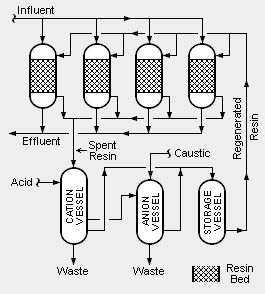User:Milton Beychok/Sandbox: Difference between revisions
imported>Milton Beychok |
imported>Milton Beychok |
||
| Line 5: | Line 5: | ||
==The ion exchange process mechanism== | ==The ion exchange process mechanism== | ||
{{Image|Ion Exchange.PNG|right|322px|Diagram depicting how ion exchange resins work. | {{Image|Ion Exchange.PNG|right|322px|Diagram depicting how ion exchange resins work.}} | ||
Ion exchange is a reversible chemical reaction wherein [[ion]]s ([[atom]]s or [[molecule]]s that have lost or gained an [[electron]] and thus acquired an electrical charge) present in a solution are exchanged for a similarly charged ion attached to an immobile solid particle of ion exchange material.<ref>{{cite book|author=Clive E. Harland|title=Ion Exchange: Theory and Practice|edition=2nd Edition|publisher=Royal Society of Chemistry|year=1994|id=ISBN 0-85186-484-8}}</ref><ref>[http://www.remco.com/ix.htm Ion Exchange Basic Concepts]</ref> | Ion exchange is a reversible chemical reaction wherein [[ion]]s ([[atom]]s or [[molecule]]s that have lost or gained an [[electron]] and thus acquired an electrical charge) present in a solution are exchanged for a similarly charged ion attached to an immobile solid particle of ion exchange material.<ref>{{cite book|author=Clive E. Harland|title=Ion Exchange: Theory and Practice|edition=2nd Edition|publisher=Royal Society of Chemistry|year=1994|id=ISBN 0-85186-484-8}}</ref><ref>[http://www.remco.com/ix.htm Ion Exchange Basic Concepts]</ref> | ||
Revision as of 17:34, 6 August 2009
Condensate polishing is an ion exchange process used to purify the steam condensate produced in high-pressure steam generation facilities[1][2][3][4] such as those in large thermal power plants.[5] Steam condensate is the water formed by condensing the exhaust steam from the steam-driven turbines in thermal power plants and which is recycled for reuse as the major part of the steam generation feedwater.
Condensate polishing is a unique application of ion exchange resins that removes suspended and dissolved impurities from the condensate. It is essential for the very stringent quality required of high-pressure steam generation feedwater.
The ion exchange process mechanism
Ion exchange is a reversible chemical reaction wherein ions (atoms or molecules that have lost or gained an electron and thus acquired an electrical charge) present in a solution are exchanged for a similarly charged ion attached to an immobile solid particle of ion exchange material.[6][7]
By charging (i.e., treating) ion exchange material with an acid, usually sulfuric acid (H2SO4) or hydrochloric acid (HCl), positively charged hydrogen ions (H+) Cite error: Invalid <ref> tag; invalid names, e.g. too many[8] As shown in the diagram, when those beads are contacted with sodium cations (Na+) and chlorine anions (Cl-) derived from dissolved sodium chloride in solution:
- The Na+ cations are attracted to the cation resin and exchange places with the H+ cations on the resin.
- The Cl- anions are attracted to the anion resin and exchange place with the OH- anions on the resin.
- The H+ cations removed from the cation resin and the OH- anions removed from the anion resin combine with each other to form a molecule of water that has no charge.
That illustrates how ion exchange material removes dissolved substances from steam condensate or any other solution.
Once all of the charged ions attached on the cation and anion exchange materials have been replaced by ions removed from a solution, the ion exchange materials are refered to as spent. The spent materals can be regenerated (i.e., rejuvenated) by once again being charged with acid or caustic.
The ion exhange materials can be naturally occurring zeolites or synthetically produced polymeric resins. The synthetic resins are the most commonly used today because their characteristics can be tailored to specific applications.
Types of condensate polishing
References
- ↑ Larry Drbal, Kayla Westra and Pat Boston (1996). Power Plant Engineering, 1st Edition. Springer. ISBN 0-412-06401-4.
- ↑ Brad Buecker (2000). Fundamentals of Steam Generation Chemistry, 1st Edition. Penwell. ISBN 0-87814-750-0.
- ↑ Condensate Polishing Guidelines Electric Power Research Institute (EPRI), 1996
- ↑ Condensate Polishing State of Knowledge Assessment Electric Power Research Institute (EPRI), 2006
- ↑ Either nuclear or fuel-fired power plants
- ↑ Clive E. Harland (1994). Ion Exchange: Theory and Practice, 2nd Edition. Royal Society of Chemistry. ISBN 0-85186-484-8.
- ↑ Ion Exchange Basic Concepts
- ↑ The Role of Ion Exchange Resins in Long-Term Spent Fuel Storage] Joseph Rideaux, 1998, Westinghouse Savannah River Company. A report of the U.S. Department of Energy. See Figure 3.

